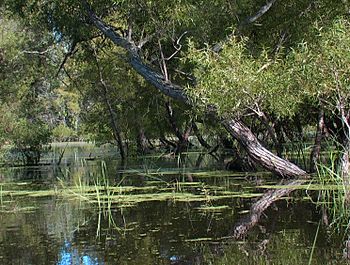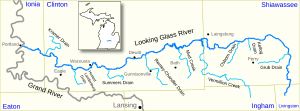Looking Glass River facts for kids
Quick facts for kids Looking Glass River |
|
|---|---|

The river in A Looking Glass Sanctuary, a nature preserve in Clinton County
|
|
 |
|
| Physical characteristics | |
| Main source | Conway Township, Livingston County, Michigan, US 42°45′16″N 84°07′40″W / 42.754581°N 84.12773°W |
| River mouth | Portland, Michigan, US 42°52′17″N 84°54′08″W / 42.871252°N 84.90221°W |
| Length | 71 mi (114 km) |
| Basin features | |
| Progression | Grand River → Lake Michigan |
The Looking Glass River is a cool river in the U.S. state of Michigan. It flows right through the middle part of Michigan's Lower Peninsula. This river is about 71 miles (114 kilometers) long. It's special because it doesn't have any dams. Plus, it flows past many natural wetlands and wooded areas.
What's in a Name?
Long ago, in the 1800s, people sometimes called this river "Wabenasebee." This name might have come from a large Chippewa settlement. This settlement, called Wabwahnahseepee, was located near where the town of De Witt is today. It was there when the first European settlers arrived.
Where Does It Flow?
The Looking Glass River starts in Conway Township. This is in the northeast part of Livingston County. From there, it flows north into Shiawassee County.
It passes between the towns of Morrice and Bancroft. Then, it turns west and goes just south of Laingsburg. After that, it runs through the southern part of Clinton County, including the town of DeWitt.
Finally, the river flows into the Grand River. This happens in Portland, which is in the southeast part of Ionia County.
When the river first starts, it's a slow and calm waterway with a soft bottom. For about 25 miles (40 kilometers) between Livingston County and Laingsburg, the river is usually 10 to 18 feet (3 to 5.5 meters) wide. Further downstream, especially below DeWitt, the river becomes more active. This part of the river is great for fishing and canoeing!
Who Lived Here First?
The very first people known to live near the Looking Glass River were the Sauk people. Later, people from the Chippewa and Ottawa tribes lived there. This area was very important to them because it had lots of animals for hunting and plenty of fish.
White settlers began to arrive in the area later. They followed trails that went up the Flint and Shiawassee rivers. These trails led inland from cities like Detroit and Port Huron.
Protecting the River
In Clinton County, a special place called the A Looking Glass Sanctuary helps protect the river. This nature preserve is about 13 acres (5.3 hectares) in size. It is owned by the Michigan Nature Association, a group that works to save natural areas.

